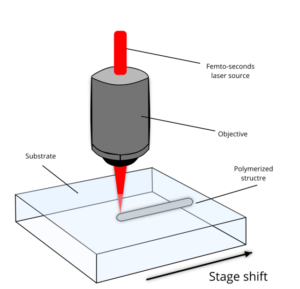New communication technology such as ultra-wideband and 5G is increasing the demand for Photonic Integrated Circuits (PIC). PIC was thought of as being a planar structure that can only guide light in a single plane but research from Dr. Gao Hongwei, from the Singapore University, shows that PIC can be 3-D structures that can guide light in two planes.
PIC manufacturing is done through multiphoton lithography, which uses a femtosecond light source incident on a photosensitive material where the two-photon absorption causes the photosensitive material to polymerize and that allows for the desired structure or pattern to be formed. Below is a visual of how a femtosecond laser pulse can be used for two-photon polarization. Dr. Hongwei and his group created a spiral and air-bridge configuration which can be seen in the published paper ‘High-Resolution 3D Printed Photonic Waveguides’ [1].

The figure shows a femtosecond laser pulse source that polymerized a structure within the photosensitive substrate that is then processed to take out of the substrate
The benefit of PIC is the improvement of current technology, for example, PIC is shown to have a 1.6 dB loss while current industry circuits experience a 1 dB loss with extremely complex and labor-intensive circuits. Other benefits of PIC waveguides is that it is shown to have an error-free 30Gbps Non-Return-to-Zero and 56 Gbps Pulse Amplitude Modulation level 4 data transmission [2]. This is an important achievement in telecommunication systems because these highspeed benchmarks are used in current telecommunication systems, meaning that these 3D PIC can be integrated immediately into existing systems.
Related Links
Article: Light Confinement in 3D Space
Paper: High-Resolution 3D Printed Photonic Waveguides
